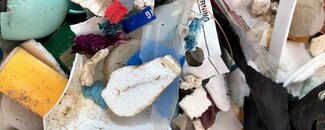NCEI’s Microplastics Portal provides access to marine microplastics data

Plastic is the most prevalent type of marine debris found in the ocean and Great Lakes. While plastic debris can come in all shapes and sizes, those that are less than five millimeters in length (about the size of a sesame seed) are known as “microplastics.”
Microplastics come from a variety of sources, including from larger plastic debris that degrades into smaller and smaller pieces. In addition, microbeads, a type of microplastic, are very tiny pieces of manufactured polyethylene plastic that are added as exfoliants to health and beauty products, such as some cleansers and toothpastes.
To make it easier to access global microplastic data, NOAA and its cooperative institute partner, the Northern Gulf Institute, created the NCEI Marine Microplastics Portal.
Microplastics: Everywhere and Always
Most microplastics start their journey on land and are carried by rivers and wind to the ocean, where they are caught in the global ocean circulation system. Microplastics have been found on beaches around the world, even in our protected areas, and have been documented in sea ice in the Arctic and on the ocean floor. Once they enter the ocean, it can be difficult to understand where exactly these tiny plastics have come from.
Once microplastics are in the ocean, they break down into even tinier particles (called nanoplastics) and accumulate in the food chain, posing a threat to fish and other marine organisms that ingest them. The most commonly used plastics break down into smaller and smaller pieces and never fully degrade in the ocean. Instead, they exist indefinitely.
Tiny Particles, Big Issues
Microplastics have been found in the stomachs of many different types of wildlife, from the smallest species of plankton to large whales. Microplastics also have been found in the air, tap water, sea salt, bottled water, beer, and the fish that humans eat. Scientists are still researching the effects of microplastics on human health.
Besides posing a potential threat to human health, microplastic pollution has steep economic impacts. About 20% of the global population relies on seafood for protein, and marine plastics endanger this food source by reducing the efficiency and productivity of aquaculture and commercial fisheries due to fish mortality. It is estimated that there is a marine ecosystem loss of between $3,300 to $33,000 annually for each ton of plastic that enters the ocean.
These small pieces of debris are a research priority for scientists around the world, and more research is needed to understand how all animals, including humans, might be affected.
Access to Global Data
One of the challenges to understanding microplastics is access to large-scale, long-term comprehensive data. Until recently, the management of marine debris data from large-scale visual surveys along the coast and in the open ocean has lagged behind the needs of the scientific and decision-making community.
To address the need for easy access to global microplastic data, NCEI developed the publicly available NCEI Marine Microplastics Portal. The portal includes a database with all types of marine microplastics information that has been aggregated, archived, and delivered in a consistent and reliable manner. These data have been provided by contributors from various research cruises and fieldwork around the globe.
The portal has information on the occurrence, distribution, and quantity of global microplastics. Data are available to download in CSV, JSON, and GeoJSON formats. Users can download the entire dataset or a subset of data for a particular geographical region, time period, or other criteria. An interactive map within the portal shows the global distribution of data submitted. The map enables users to filter and view data by specific criteria including date, ocean, region, and sampling method.
The microplastics database would not be possible without the help of worldwide data contributors. Data contributors are always referenced in the portal. To submit your own microplastic data to the archive, please contact NCEI at ncei.info@noaa.gov. Find more information on submitting data on our Archive page.



